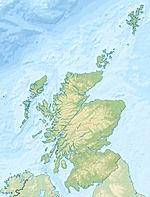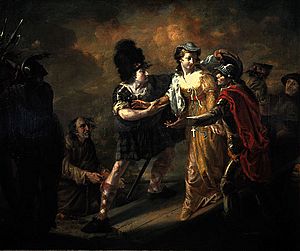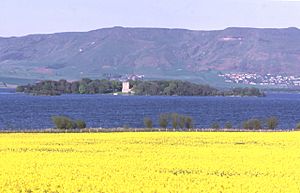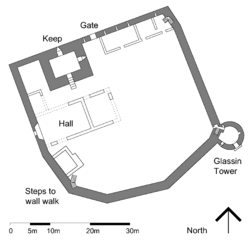Lochleven Castle facts for kids
Quick facts for kids Lochleven Castle |
|
|---|---|
| Castle Island, Loch Leven, near Kinross, Scotland UK grid reference NO137017 |
|
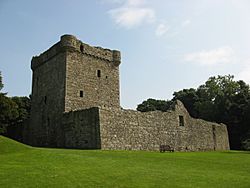
Keep and west wall of the castle
|
|
| Coordinates | 56°12′N 3°23′W / 56.20°N 3.39°W |
| Type | Tower house and courtyard |
| Site information | |
| Owner | Historic Scotland |
| Controlled by | Douglas of Lochleven |
| Open to the public |
Yes |
| Condition | Ruined |
| Site history | |
| Built | 1300 AD |
| In use | Until 17th century |
| Materials | Stone |
Lochleven Castle is a ruined castle located on an island in Loch Leven, in Scotland. It was likely built around the year 1300. This castle played an important role in the Wars of Scottish Independence (1296–1357), which were battles fought to decide if Scotland would be an independent country.
Later, in the 1300s, the castle was given to the Douglas family. They owned it for about 300 years. One of the most famous events at Lochleven Castle was the imprisonment of Mary, Queen of Scots, from 1567 to 1568. She was forced to give up her crown there, but she later escaped with help from her jailer's family.
In 1588, the person who had held Mary prisoner became the Earl of Morton and moved away. In 1675, a famous architect named Sir William Bruce bought the castle. He used it as a beautiful feature in his garden, and it was never lived in again.
Today, the castle ruins are protected by Historic Environment Scotland. You can visit Lochleven Castle in the summer by taking a ferry.
Contents
History of Lochleven Castle
Early Days and Battles
A castle might have stood on Castle Island as early as 1257. At that time, Alexander III of Scotland, who was only 16, was brought there by his guardians. During the First War of Scottish Independence (1296–1328), the English army took control of Lochleven Castle. Its location was very important, as it was between the major towns of Edinburgh, Stirling, and Perth.
Some parts of the castle's walls, called the curtain wall, might have been built by the English during this period. However, Scottish forces, possibly led by William Wallace, captured the castle before the 1200s ended.
The English tried to capture Lochleven again in 1301, but Scottish forces, led by Sir John Comyn, broke the siege. King Robert the Bruce (who ruled from 1306 to 1329) visited the castle in 1313 and again in 1323.
After Robert the Bruce died, the English invaded Scotland once more. In 1335, they tried to flood Lochleven Castle by building a dam across the loch's outflow. The water level rose, but the castle's defenders, led by Alan de Vipont, damaged the dam. This caused it to collapse and flood the English camp. However, some historians doubt if this story is completely true.
Building the Tower House and Royal Prisoners
In the 1300s or early 1400s, a five-story tower house (also called a keep) was added to Lochleven Castle. This made the castle stronger. Historic Scotland believes it was built in the 1300s, making it one of Scotland's oldest tower houses still standing.
In 1390, King Robert II gave the castle to Sir Henry Douglas. From the 1300s onwards, the castle was used as a state prison. Many important people were held there. These included Robert II himself in 1369 (before he became king) and Patrick Graham, the Archbishop of St Andrews, who died there in 1478.
Mary, Queen of Scots, Imprisoned
Mary, Queen of Scots (who ruled from 1542 to 1567), visited Lochleven Castle a few times before her imprisonment. In 1562, she stayed there to recover after falling from her horse. In 1565, she met with the famous preacher John Knox at the castle.
Two years later, Mary returned to Lochleven as a prisoner. She was held there from June 17, 1567, until her escape on May 2, 1568. She had been captured after the Battle of Carberry Hill because many noblemen did not approve of her marriage to the Earl of Bothwell. She was placed under the care of Sir William Douglas of Lochleven.
During most of her time as a prisoner, Mary lived in the Glassin Tower, which was built in the early 1500s. Sir William Douglas's daughters sometimes slept in her room for extra safety. Mary's household at the castle was small, including only a few servants.
Mary became ill when she arrived and sadly lost her babies. A few days later, she was forced to abdicate (give up) her crown. She had to sign papers making her infant son James the new King of Scots.
Mary slowly recovered during the autumn and winter. She managed to win over George Douglas, Sir William's brother, who fell in love with her. Mary asked her servant to send her materials for sewing and embroidery. She also tried to escape several times. Once, she dressed as a laundress, but the boatman recognized her and took her back. Another time, she planned to climb a wall, but one of her ladies-in-waiting got hurt while they practiced.
On the night she finally escaped, Mary dressed as a servant. Willie Douglas, a young relative of the family, stole the keys. Mary was then rowed across the loch to where George Douglas and 200 horsemen were waiting. They rode away to Niddry Castle.
Old keys found when the loch's water level was lowered in the 1800s are said to be the ones Willie Douglas took. Some people say Lochleven Castle is haunted by Mary's spirit. They believe she is waiting for her lost babies.
Another important prisoner held here was the English Earl of Northumberland. He was imprisoned for two years after upsetting Elizabeth I of England. He was later sent back to England and executed.
In 1588, Sir William Douglas became the 6th Earl of Morton. He inherited other properties, like Aberdour Castle, so Lochleven Castle was used less often.
Sir William Bruce and the Castle's New Purpose
Around 1546, Margaret Erskine and her son William Douglas built a new house on the shore of the loch, called "Newhouse." This new house became the main home for the estate in 1619.
In 1675, Sir William Bruce (c.1630–1710), who was the royal architect in Scotland, bought the Loch Leven estate. Bruce built a grand new home called Kinross House starting in 1686. He designed the house and its gardens so that the old Lochleven Castle on the island was a beautiful view from his new home. The "Newhouse" was later taken down in 1723.
Kinross House was one of the first buildings in Scotland built in the classical style. After this, Lochleven Castle was no longer used as a place to live. Instead, Sir William Bruce kept it as a picturesque ruin to admire from his gardens.
Recent Times
Lochleven Castle was already a ruin by the 1700s. However, efforts were made to preserve the ruins and clear away rubbish in 1840. The estate changed hands a few times over the years.
In 1939, Lochleven Castle was given to the care of the state. Today, Historic Environment Scotland manages it. During the summer months, visitors can take a ferry from Kinross to reach the castle. The castle ruins are protected as a Scheduled Ancient Monument.
What Lochleven Castle Looks Like
The castle and its outer walls once covered almost the entire Castle Island. The island you see today, which is larger and has trees, was formed in the early 1800s. This happened when the River Leven was made into a canal, which lowered the water level of the loch a lot.
The castle has a rectangular courtyard surrounded by a curtain wall. There is a tower house, or keep, at one corner. The round Glassin Tower sticks out from the opposite corner. You can still see the foundations of other buildings that once stood around two sides of the courtyard. Of the outer court, only a raised earth bank shows where the walls were, and there are small remains of a bakehouse.
The Tower House
The tower house, or keep, is at the west corner of the castle. It measures about 11 meters by 9.6 meters. It originally had five stories, but its roof and wooden floors are now gone. The lowest level was a vaulted basement. Above that was a vaulted kitchen. The main hall was on the next floor, with other rooms above it. All these levels were connected by a spiral staircase.
The Glassin Tower
The Glassin Tower is a round tower built into the south-east corner of the old curtain wall, probably around 1550. No one is sure where the name 'Glassin' comes from. This tower was added to provide more rooms and to make the castle look more impressive. It also had Gunholes, which were openings for guns, to help defend the castle.
The tower has a vaulted basement for storing water. This basement had separate channels to bring water from the loch and to drain waste water. The room above the basement had a special window called an oriel window, which gave great views over the loch. The top room was likely a bedchamber. At the very top, a small room, only reached from the wall walk, might have been a study or library.
Archaeological Discoveries
In 1995, a small excavation (dig) found the base and two steps of a stone stairway. This stairway led to the Great Hall of the tower. During the dig, pottery from the 1500s and animal bones were found in about 0.75 meters of debris near the staircase.
See also
 In Spanish: Castillo de Lochleven para niños
In Spanish: Castillo de Lochleven para niños


